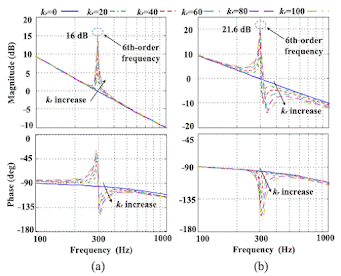ABSTRACT:
The brushless doubly fed machine (BDFM) drive system based on a fractional unidirectional converter is a promising low-cost variable-speed drive system, which shows great potential in applications of driving fans and pumps. However, the harmonic current generated by a diode rectifier can flow into the machine and the grid under a weak grid, which will cause a 6th-order frequency torque ripple and lead to voltage distortion. A steady equivalent circuit considering the uncontrolled rectifier and the grid impedance is built firstly to study the harmonic distribution characteristics. To eliminate the influence of harmonic currents, the harmonic equivalent impedance of the machine system should be regulated to change the harmonic distribution characteristics. This paper improves the conventional control method through adding a harmonic control loop to prevent harmonic currents from being injected into the machine or the grid, which is then applied in the fundamental synchronous frame. Two indirect parameters are selected to realize the two control targets. Afterwards, the influence of the control system on the harmonic equivalent impedance of the machine system under the conventional method and the proposed method are compared. Finally, experimental results obtained from a 30 kW BDFM prototype verify the proposed method.
KEYWORDS:
1. Brushless
doubly fed machine
2. Fractional
unidirectional converter
3. Harmonic
current control
4. Weak
grid
SOFTWARE: MATLAB/SIMULINK
SCHEMATIC DIAGRAM:
Figure 1. The Structure Of The BDFM Drive System With A Unidirectional Converter.
EXPECTED SIMULATION RESULTS:
Figure 2. Simulation Results Of The Msogi-Fll With
An 11 Kw Diode Rectifier Load Switched In The Weak Grid.
Figure 3. Pw Currents And The Grid Current
Sensitivity To The Diode Rectifier Current In Proposed Control Structure: (A)
Magnitude Frequency Response Of G1irecpir ; (B) Magnitude Frequency Response Of
G2irecpir .
Figure 4. Bode Diagrams Of The Open-Loop Transfer
Function In (28) With Different Kr : (A) Target I; (B) Target Ii.
Figure 5. The Maximum Cw Voltages Of The Two
Control Targets At Different Speeds.
CONCLUSION:
The
BDFM variable speed drive system based on a fractional unidirectional converter
has wide application prospects for loads that require only limited range speed
regulation. To solve the influence of harmonics on system, this paper studies
the harmonic characteristics through a new equivalent circuit and proposes a
direct harmonic control strategy. It is shown that:
1)
The harmonic current contents in the machine and the grid are determined by the
grid harmonic impedance and the harmonic equivalent impedance of the machine
system. Calculation results agree with the experiment data;
2)
The nature of the bidirectional harmonic currents control between the weak grid
and the machine is changing the harmonic distribution characteristics of the
BDFM driving sys- tem shown in Fig. 1, while the conventional control method can
hardly realize this target;
3)
The torque ripples and the harmonic currents injecting into the grid can be
controlled indirectly through iph and uph;
4)
The proposed control method can regulate the harmonic equivalent impedance of
the machine system effectively, which commendably realizes the bidirectional
harmonic cur- rent control. The equivalent circuit structure and control method
pro- posed in this paper are also suitable for distorted grid with a large
number of nonlinear loads. In this operation environment, a single BDFM control
system is insufficient to improve the grid, which will be studied in the
future.
REFERENCES:
[1]
X. Chen and X.Wang, ``Proximate standing wave feature of magnetic field and its
influence on the performance of wound rotor brushless doubly- fed machine,'' IEEE
Trans. Energy Convers., vol. 32, no. 1, pp. 296_308, Mar. 2017.
[2]
J. Su, Y. Chen, D. Zhang, and Y. Kang, ``Stand-alone brushless doubly fed
generation control system with feedforward parameters identification,'' IEEE
Trans. Ind. Informat., vol. 15, no. 11, pp. 6011_6022, Nov. 2019.
[3]
J. Chen, X. Wang, T. Zhao, Z. Li, M. Kong, and P. Nie, ``Application of brushless
doubly-fed machine system in hydropower generation,'' in Proc. 22nd Int.
Conf. Electr. Mach. Syst. (ICEMS), Harbin, China, Aug. 2019, pp. 1_4.
[4]
T. D. Strous, H. Polinder, and J. A. Ferreira, ``Brushless doubly-fed induction
machines for wind turbines: Developments and research challenges,'' IET
Electr. Power Appl., vol. 11, no. 6, pp. 991_1000, Jul. 2017.
[5]
M. Kong, X. Wang, Z. Li, and P. Nie, ``Asynchronous operation characteristics
and soft-starting method for the brushless doubly-fed motor,'' IET Electr.
Power Appl., vol. 11, no. 7, pp. 1276_1283, Aug. 2017.




